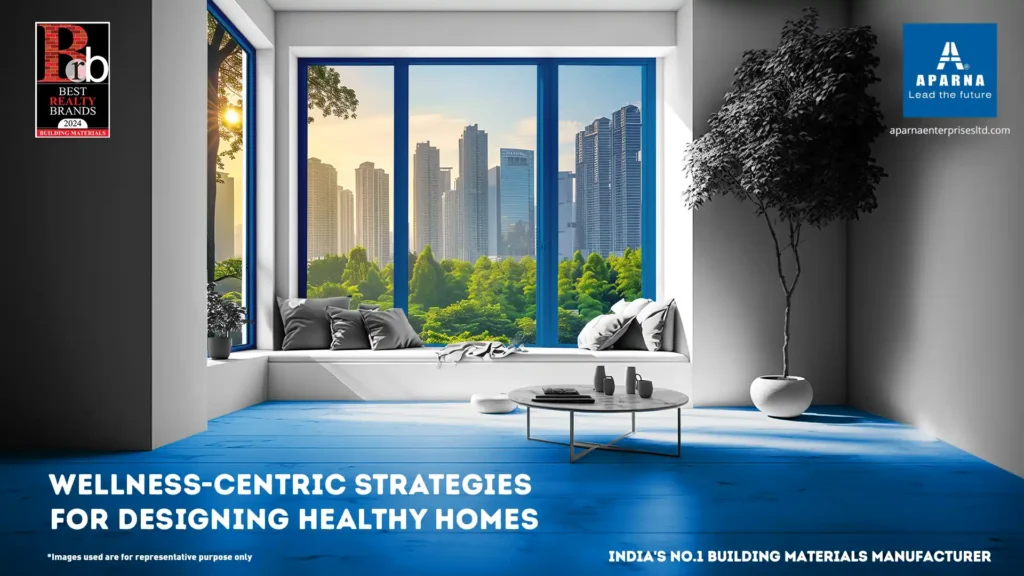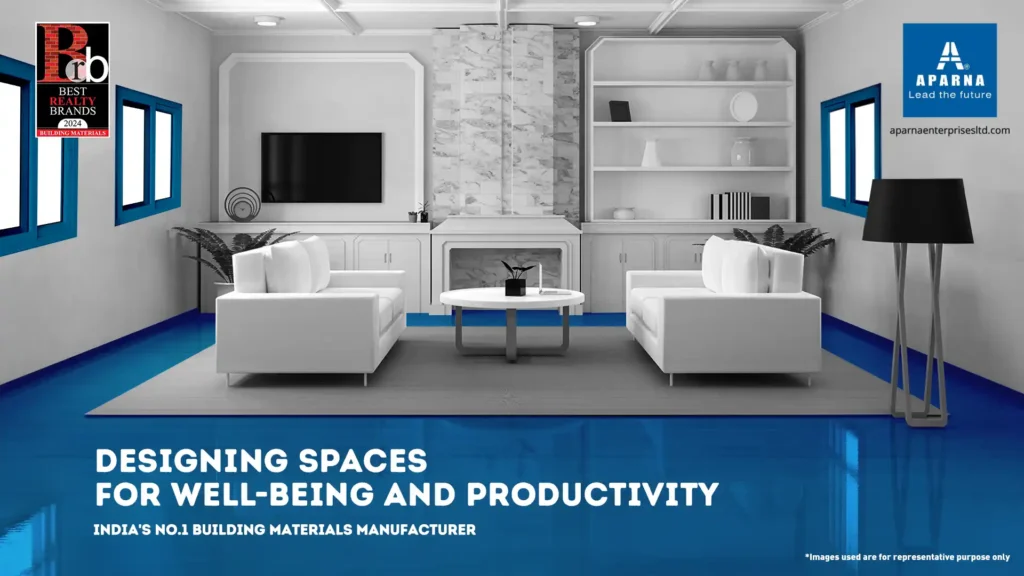Tag: sliding wardrobe design
Wellness-Centric Strategies for Designing Healthy Homes

In today’s fast-paced world, our homes have a profound impact on our mental and physical well-being. Using wellness home design ideas helps elevate the quality of our lives. They help promote a healthy lifestyle and drive superior psychological well-being. Overall, it is about creating spaces that reflect your personality, style, and touch every walk of your life.
The best thing about creating wellness-centric homes is that it can be achieved with thoughtful choices in design. It extends far beyond aesthetics and fashion. Read the blog to know the ideas and expert insights on design.
Wellness home design ideas
Designing a wellness-centric home helps enhance mental, physical, and psychological well-being. In this section, let us explore some of the key design ideas to enhance the well-being of your home.
1. Organize your space
When you plan the layout of your space, work on the flow. A cramped space can impact your mental well-being, focus, and concentration. It can lead to stress and chaos. An organized space helps calm your mind.
You must work out design ideas based on the requirements of the space. For example, when it comes to the kitchen, using a modular kitchen design helps organise the space. Innovative options like vertical storage and pull-out drawers help declutter the kitchen area.
On the other hand, using smart storage solutions like sliding wardrobe design helps organise the clothes and dressing area. Using innovative options like sliding wardrobe design, and dust-resistant properties helps improve the aesthetics of the space.
2. Noise insulation
External noise disrupts the emotional well-being of the space. Using sound-absorbing materials for carpets, curtains, etc. helps minimise the noise and distraction from outside. Using aluminium doors and windows with high sound insulation also helps maintain perfect acoustics.
Similarly, using uPVC doors and windows helps weed out external noise and disturbances. They promote healthy sleep and minimise stress levels. This makes materials like uPVC and aluminium, a perfect option for homes in high footfall regions and urban areas.
3. Design for natural light and ventilation
Natural light and ventilation are some of the key elements when it comes to wellness home design ideas. Proper lighting brightens up the mood prevailing in the space. On the other hand, poor lighting may strain the eyes and lead to stress while impacting the quality of our lives.
Aluminium doors and windows come in sleek, minimalist designs. They allow for larger glass panes creating space for enhanced lighting and ventilation. Using double-glazed or insulated glass helps maintain an optimal internal temperature and healthy interior.
When it comes to tiles and flooring materials, using reflective ones helps enhance the flow of natural light into your home. For instance, using ceramic tiles helps amplify the natural light flowing into the space and this brightens up the mood prevailing inside. This also reduces the need for artificial lighting.
4. Use sustainable, wellness-centric materials
When you choose construction materials, choose ones that are healthy, non-toxic, sustainable, and environmentally friendly. Here are some examples:
Sustainable floor tiles:
Using ceramic tiles and glazed vitrified tiles enhances not only the aesthetics of the space, but they are also eco-friendly. They are also resistant to stains, dust, cracks, and scratches which reduces the hardships in maintenance and cleaning.
When it comes to bathroom and kitchen floor tiles, using innovative ones like vitrified tiles enhances slip resistance. This is highly important when you have elderly and children living in the home. Also, these tile options are easy to clean and maintain making them an ideal choice for bathroom and kitchen areas.
Lead-free uPVC doors and windows:
Traditionally, the uPVC materials contained lead, exposure of which is harmful and toxic. This is true, particularly for children, who when exposed to the toxic lead cause health complications impacting the quality of air inside the space.
uPVC doors and windows manufactured and supplied by Aparna Enterprises Limited (AEL) are 100% lead free and thus help in promoting a healthier living space.
5. Enhance your connectivity with nature
Natural elements calm down your body, mind, and soul. By fostering a greater connection with nature, you can boost your physical and mental wellness in space.
As explained earlier, allowing room for ample natural light to pass through and improving the ventilation of the space helps reduce the line between indoors and outdoors. For instance, folding or sliding uPVC doors helps achieve a greener space with ample natural light.
Also, using indoor plants helps add a natural touch to the space, while blurring the fringes between indoors and outdoors. If you have a small area, you should use innovative ones like vertical gardens. Doing so helps minimise the stress in the space and promotes a relaxed ambiance.
Wrapping Up
Designing a wellness-centric home is all about nurturing a healthy environment for your mind, soul, and body. Wellness home design ideas like noise insulation, enhancing natural connectivity, sustainable materials, improving the flow of natural light, and using smart technologies help boost the ethos prevailing in the space.
Using uPVC and aluminium doors and windows helps regulate the interior room temperature and bridge the gap between indoors and outdoors. This helps nurture a harmonious space inside the building.
FAQs
1. What are the best tiles for a wellness-centric home?
Modern options like vitrified floor tiles,, glazed vitrified tiles, etc. have dust and stain resistance and help maintain a clean interior. Options like vitrified floor tiles are reflective and allow ample natural light to pass through. This brightens up the space and enhances the quality of life inside.
2. What storage solutions are appropriate for a clutter-free interior?
Using modular wardrobe designs and modular kitchen layouts helps organise the space and achieve a clutter-free interior. This helps minimise the time spent on searching for stuff and instead focus more on the core activities.
Designing Spaces for Well-being and Productivity

Have you ever felt calm in a clutter-free, well-designed space? On the other hand, a cluttered environment slows you down and influences your productivity. The quality of interior design impacts our routines and behaviours.
The majority of habits and behavioural patterns evolve as a reaction to the environment. While there exists no one-size-fits-all solution to interior designs, thoughtful ones can improve the well-being and overall productivity of the space.
Read the blog to learn the psychological impact of interior design. The ideas would help achieve superior productivity and improved well-being in interior design.
Key factors affecting well-being and productivity
The following are some of the key factors affecting the productivity and well-being of the residents in a space.
1. Lighting
Natural light boosts the wellness of a space and plays a key role in regulating the human body’s circadian rhythm. Insufficient lighting may cause stress and fatigue impacting overall productivity. On the other hand, bright lights improve the mood of the space and help foster a positive work environment.
2. Space organisation
Organised spaces instil a sense of calmness in human minds. They help bring about focus, clarity, and concentration in work. They reduce the time one has to spend searching for files, tools, etc. This leaves more space and time for critical work which in turn enhances the overall productivity.
For instance, using modular kitchen cabinets and sliding wardrobe design help declutter the cooking space. This helps reduce the time needed for actual cooking.
3. Noise levels
Continuous noise from the outside environment distorts the focus and increases the likelihood of errors. Exposure to noise also leads to stress and fatigue impacting well-being and productivity. Enhancing the acoustics with noise-cancellation and soundproof materials helps nurture a healthy environment.
For instance, using uPVC and aluminium doors and windows offers greater insulation against external noise, reduces distraction, and improves mental well-being.
4. Air quality
Poor air quality causes headaches and fatigue eventually impacting well-being and productivity. Working in a space with proper ventilation improves mental alertness and focus.
Such materials help maintain warmth during cold winters by minimising heat transfer. Similarly, in hot summers, they help maintain an optimal room temperature. All these enhance the productivity of the space.
5. Comfortable flooring
Flooring plays a key role in promoting the well-being of a space. Smooth, leveled surfaces minimize strain while walking and standing. The colour and texture of the floor also impact the mood prevailing in the space. Also, opting for those that have lower maintenance needs minimise the spent on cleaning and this ensures an uninterrupted flow of other operations in the house or office space.
How to improve the well-being and productivity of a space?
Here are a few tips to organise the space more efficiently and deliver superior comfort, productivity, and functionality.
1. Modular kitchen design
A well-designed kitchen increases the efficiency of your daily routine. Modular kitchen cabinets enhance the functionality and organisation of the kitchen space. As they help keep the kitchen free of clutter, modular kitchen design helps minimise the time taken for cooking.
The best thing about modular kitchens is that they can be fully customized to your space and layout. With vertical storage and pull-out drawers, the modular kitchen design for small spaces helps achieve greater productivity in the available space.
2. Functional wardrobe design
Wardrobes have become an essential component in organising the interior space. Innovative options like sliding doors help save space and achieve a modern, contemporary appeal. Sliding wardrobe designs enhance the aesthetics and appeal of the space, irrespective of the size and layout of the space.
Efficient wardrobe design helps categorise the storage space making it easier to find clothes and other items. So, when you look for wardrobes, look for features like sliding doors, dust resistance, etc. to ensure that they remain clean and organised.
3. Floor tile designs
Floor tile designs define the character of a space. As explained earlier, leveled floor tile designs help minimise the strain caused while standing or walking. If you are exploring the best tiles for the floor, choose vitrified tiles. They are smooth and offer greater thermal insulation. Also, vitrified tiles come in different colours, textures, and styles which in turn impacts the mood prevailing in the space.
As vitrified tiles are non-porous, they remain resistant to stains and spills. This in turn reduces the need for frequent maintenance and minimises the disruption that may result, otherwise.
4. Right materials for doors and windows
Using the right materials for doors and windows enhances the efficiency of the home. Materials like uPVC and aluminium enhance the strength and durability of the doors and windows. As they offer superior insulation, they help maintain an optimal temperature all year long.
Aluminium doors and windows are sleek and add a minimalist look. Choosing the right type of doors and windows helps improve the lighting and ventilation in the interior. All these help create a comfortable, more efficient interior which in turn boosts the productivity and functionality of the space. So, when you plan your interiors, invest your time in understanding the properties of the materials used.
Elevate the productivity of your space with modern interiors
Making thoughtful choices in interior design can boost the productivity of the space and promote superior well-being. The lighting, noise levels, air quality, clutter, and comfortable flooring are key elements that determine the productivity of a space. So, choose materials that promote optimal temperature, air quality, and acoustics.
Using modular kitchen design, wardrobes, aluminium doors and windows, uPVC doors and windows, glazed vitrified tiles, etc. some of the innovative ideas to drive the efficiency of a space. All these design elements drive superior aesthetics while also promoting the efficiency and functionality of the interior space.
FAQs
1. What are the most crucial elements in designing a productive interior space?
The following are some of the important elements when it comes to the well-being of a space.
- Lighting
- Colour psychology
- Comfortable flooring
- Noise levels
- Air quality
- Natural elements
2. How does AEL improve the well-being of a space?
AEL offers innovative solutions that help keep the space organised and clutter-free. The following are some of the examples:
- Modular kitchen cabinet
- Functional wardrobes
- Comfortable flooring options
- uPVC windows and doors
- Aluminium doors and windows
- Vitrified tiles
